My Search for a Life Partner
Friday, July 27, 2018—2:45 pm—75˚F (25˚C)—Mostly sunny
In early 2018, Sumi’s caregiver would bring her 16-month-old daughter to our house while she worked. At first it worked well, as her daughter would stay in a play-pen and watch Sesame Street on TV while her mother was attending Sumi. After a few months, though, this arrangement was not working. The girl had grown and was climbing out of the play-pen. So, as a solution, Sumi’s caregiver brought her neighbor, who she was close with and knew well, and the neighbor took care of her daughter while Sumi’s caregiver took care of Sumi.
The neighbor was from India and one day while I was chatting with her I learned she had lived in the US for four years and didn’t work. Since I knew she was married, I asked about it.
She responded, “It was four years ago in a town in central India.” Then she further volunteered, “I am 24 and at the time of the marriage I was 20-years-old. It was an arranged marriage.”
While we were talking my mind went back to the time Sumi and I were married. Sumi was 20- years-old. We were married in India and then I brought Sumi to the US. I could see the image of a younger Sumi in my neighbor. As Yogi Berra said, “It was like déjà vu all over again!”
Then, the neighbor asked me, “Were yours and Sumi’s marriage arranged?”
In India, then and now, marriages are broadly classified into two categories: Arranged Marriages and Love Marriages.
Arranged Marriages are when people other than the bride and groom, mostly parents from both sides, decide on the suitability of the couple. Each side talks to the bride and groom about the arrangement and then organizes a formal introduction, usually over tea and snacks at the bride’s house, to get the bride and groom’s consent. Sometimes this formal meeting is skipped and parents from both sides prevail on the bride and groom to get married.
The other type is Love Marriages, in which the bride and groom get to know each other on their own. They date, fall in love, have courtship, and ask their parent’s permission to get married.
Many times, love marriages create a lot of conflict in the family since the authority of the elders and cultural tradition is violated.
Getting back to the neighbor’s question about if Sumi and my marriage was arranged, I thought for a while and said, “No, and yes.” It’s no because our parents did not arrange our marriage. But it’s also a yes because Sumi and I did not know each other and hadn’t dated or courted before marrying.
At that point, the caregiver’s daughter needed attention so we had to stop talking. It was a welcome relief for me, as I did not want to go into the detailed explanation about my mixed answer.
It was January 7, 1974. The day I had gotten my green card (United States lawful permanent residency). It was one of the happiest days of my life, as my plan to stay in the US materialized, thanks primarily to Alan Becker of D. Becher & Sons where I was working. He was instrumental in sponsoring my green card through a local lawyer.
At that time, I was working and living in Philadelphia as I had been since the fall of 1971. I first came to the US in September 1970 for further studies. I went to Berkeley, California where I eventually graduated with a Master's in Mechanical Engineering-Design. I stayed in Berkeley until the fall of 1971. California was in an economic recession and jobs were scant. I decided to go to Philadelphia to search for a job where my classmates from India were living. I hitched a ride in a Volkswagen minibus with six other people traveling from Berkeley, California to Philadelphia, Pennsylvania—a distance of about 3,000 miles (4,900 km) over four days and four nights. There, I began working for D. Becher & Sons.
In March 1974, a few weeks after getting my green card, I made my first return visit to Mumbai, India. After spending three and a half years in the US landing in Mumbai (then called Bombay) was a cultural shock in reverse. I was like a frog thrown into boiling water. I wanted to jump out!
There I was, with long shoulder-length hair, an influence of living in Berkeley, the epicenter of counterculture. In Mumbai, everything seemed strange, loud, and unclean. For the first few days I couldn’t even use the toilets. I had to go to the terminal lounge at the Mumbai Airport to use a western-type toilet. The airport was about a 20-minute one-way ride from my parent’s home. It 3 took me a few days to get used to the life I had once lived in India for the first 23 years of my life.
During my visit, as it was customary and expected in those days, my family had arranged for me to meet a potential bride! Having lived in the US for some time, I had developed a mental image of the person I wanted to spend the rest of my life with. I wished for her to have the body of a well-built, athletic, and tall woman and also be an independent thinker. At the same time, I wanted a bride with an Indian mindset with Indian cultural and family-oriented values. A blend of West and East.
Within a week, I met the girl my parents had arranged for me to consider. I had to travel by train to Ahmedabad, a city about 300 miles North of Mumbai. From there I was driven to a small town to meet her. While traveling, my mind swirled with thoughts of my ideal ‘blended girl.’ But the short one-on-one meeting with her, which was very forward in those days to not have a chaperone, didn’t go well and I told my parents, “I do not like her.” My parents wanted to know why and what was wrong with her but I didn’t have much of an answer. I did not want to quantify my decision because it was a judgment I made with my gut.
Now, as I think back, I think she had the disadvantage of being the first girl I met, as I was not yet grounded in the local scenario. I felt everyone’s ‘mission’ was to get me married. I also detected the interests of non-family ‘match-makers’ were not of what was best for
me but what was best for
them. With my decision to not marry their choice, my parents were devastated. They were under social pressures since close relatives and my maternal uncle were instrumental in the match. My parents must have thought they would ‘lose face’ in the community. This was a tough period, seeing my parents unhappy as our interests were not aligned.
While I was in Ahmedabad my older brother, Arvindbhai, was with me. I am close to him as we are close in age. Everyone involved in my ‘match-making’ were so sure of my affirmative answer no one had thought of an alternate scenario but Arvindbhai and I discussed other prospects. While we were in this limbo we happened to meet my first cousin’s 19-year-old son, Kanu (same name as mine) and he mentioned knowing a girl who might be of interest to me. He had met her at someone’s wedding and knew she had participated in the political demonstrations at her college campus. Having this suggestion come from someone much younger than me interested me because I did not see him to have a hidden agenda.
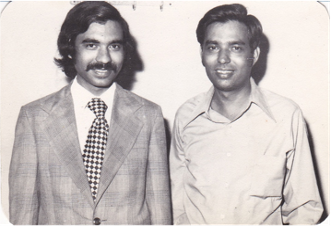
My brother, Arvindbhai, (on right) with me
Meeting this girl was so fresh of an idea Arvindbhai and I decided to pursue it on our own. We found out where she lived and decided to go directly to her house in a town called Balasinor. The bus ride from Ahmedabad to Balasinor took about two hours on the dusty and somewhat paved roads. Upon reaching her house we pretended that we had come to see her younger brother Kaushik. The girl’s older brother, Navin, told us Kaushik had gone to another town, Vijapur, for summer vacation. We asked if Navin would accompany us to Vijapur and made plans to meet the next day at the bus depot in Ahmedabad at 8 am to take a bus together.
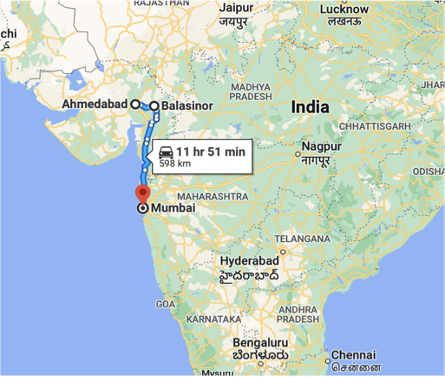
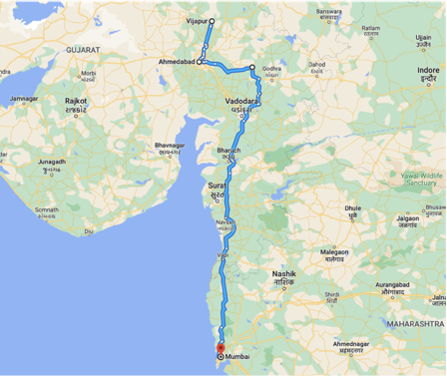
The next day came and Arvindbhai and I went to the bus station but there was no sign of Navin. We had to make an executive decision, wait for Navin or go to Vijapur on our own. In the end, we decided to go on our own and thought Navin may have gone earlier to give his family a heads-up of our visit.
Upon reaching Vijapur at about 10 am, we managed to find the right house and knocked on the door. A girl, casually dressed in a top and skirt, answered. Since my brother and I were standing a step below the entrance floor as we looked up the girl seemed taller than she was. The day before, in Balasinor, our ruse had been to see Kaushik. Now, as Navin was not with us, we improvised and after introducing ourselves asked if Navin was home. The girl told us he wasn’t and we said we’d come back in the afternoon when he was and left.
Arvindbhai and I both thought, now what? By that time they must have figured out the purpose to our visit. To kill time we visited our sister, Taraben, and her husband, Amritlal, who lived nearby. We discussed my endeavor and Taraben suggested that we return to the girl’s place in 5 the afternoon along with Amritlal who could give some seriousness and ‘weight’ to our young Turks trickery.
When we got to the girl’s house Navin was already there. They had prepared a quick lunch for us and Amritlal did most of the talking to explain the reason for our visit. Out of the discussion what emerged was my desire to have a one-on-one meeting with the girl in Ahmedabad in a couple of days. Again, a meeting without a sister or other female member of the girl’s family to monitor us from a distance was rarely asked for in those days.
Two days later, I met the girl in a restaurant—a true one-on-one! She wore a sari, a traditional Indian outfit, and had no make-up on her face. She was a little shorter than what I had imagined when I first saw her in Vijapur.
We sat at the table and after looking at the menu I asked what she would like to eat, to which she replied whatever I ordered was fine. She was kind of shy but confident, nonchalant but engaging with her effervescent smile. I am sure, like a candidate going for a job interview, she was coached about sitting erect and being engaging but to speak as little as possible in answering. However, none of that was apparent as she seemed so natural and poised.
After placing the order I asked, “What are you studying?”
She answered, “I am in the third year in college studying Literature and Arts.”
When the food arrived she didn’t eat much, saying she was not hungry. I continued asking questions and learned her college was taught in Gujarati, her Indian language, but she knew a little English from high school. Then I asked, “What do you know about America?”
She honestly said, “Not much.”
We continued with a few other non-substantive conversations and she seemed to be easily agreeable and consenting on whatever we discussed. When I asked her if she had any questions she didn’t ask much. We must have been together for less than an hour.
Afterward, my family asked me about my decision but I could not make up my mind. Events were happening so fast. I told them I needed some time to think it over. 6 In late March, Arvindbhai and I returned to Mumbai. To help clear my mind I made my first visit to Delhi, Agra to see the Taj Mahal, and Fatehpur Sikri. My travel agent in Philadelphia had arranged the free round-trip plane ticket between Mumbai and Delhi as part of my International ticket.
When I returned to Mumbai I had a few more opportunities to meet other girls through contacts my family and friends knew. I was not making much progress and was running out of time. Since I had taken a leave without pay from my job in Philadelphia I thought I might not have my job back if I stayed too long.
After a few more weeks in Mumbai, I thought about returning to the US and making another trip to India later. But my parents were insistent on me getting married before returning. The place we stayed in Mumbai had an open terrace on the roof. The center portion of the roof was tiled but there was a seven-foot flat perimeter where we could put flatbeds for sleeping. In the summer months we would sleep on the terrace under the clear star-lit night. Yes, in those days the nights were clear and I could see glittering stars all over. And on many nights when I looked at the night sky and the occasional shooting star, the image of the casually dressed girl I saw for the first time in Vijapur kept flashing in my mind. And also the conversation we had in the restaurant in Ahmedabad. I processed all these emotions viscerally—as opposed to a few of my friends who made worksheets of all the girls they had met with pros and cons and a point system to make their decision.
A month passed and it was almost the end of April. I met a few more girls in Mumbai through mutual friends but was not making progress and felt time was running out to make this important decision. The more girls I met the stronger my liking grew for the girl from Vijapur. Arvindbhai told me he also liked her. My longing for her only continued to grow and I decided that she was the right life partner for me.
Now the question was how to reopen the discussion. I told my family I would like to meet her one more time and we arranged another trip to Ahmedabad to meet her in the same restaurant as before. Again, she wore a sari. We discussed life in the US and how she would like it there. As I had already made up my mind, this meeting was much shorter. We repeated some of the discussions we had at the first meeting. She still had one more year to finish her bachelor's 7 degree but I thought it would be okay if she didn’t complete her studying since a degree in Gujarati would not be useful in the US. Also, she did not speak English but I figured it would be alright as she could learn English after coming to the US.
This second formal meeting was on May 8, 1974 and on the same day I said, “YES!” to my parents. I wanted to marry the girl from Vijapur. I wanted to marry Sumi.
Next, we had to figure out when the marriage could take place. Sumi’s side wanted six months for preparations. For that to work, I would have had to return to the US and make a second trip to India. That was not possible. I insisted that a simple marriage would be fine as I needed to return to the US as soon as possible.
There was a lot of back and forth discussions. Even though Sumi’s mother was practical and thought it was okay to have the wedding take place soon, Sumi’s father was still digesting the fact that Sumi would be leaving for the US and wanted to delay the wedding. But I held my ground that the marriage needed to happen as soon as possible. Finally, everyone agreed on May 11
th as the date, only three days after I agreed to the marriage.
To complicate things, a major strike by the workers of the Indian Railways had started. The country was paralyzed with its primary mode of travel shut down. During this time I had been stuck in Ahmedabad and my parents in Mumbai. The rest of my relatives went to Prantij, our ancestral hometown, and started the Baraat—the wedding party—using cars from my cousin’s home. But my nineteen-year-old younger brother, Satish, who had been commuting daily to Engineering College from home, was seriously ill with typhoid. My mother was taking care of him. Only my father came to Ahmedabad, riding in a car with my eldest brother and his family. My mother was faced with the choice of staying in Mumbai and missing my wedding, an unthinkable thing, or staying to take care of Satish. My brother needed her and so, she planned to stay behind.
At the last minute, our neighbor stepped in and volunteered to take care of Satish. My mother could come. She and my best friend, Gul, who was a photographer and a motorbike enthusiast, left during the night on May 10
th, the night before the wedding. They took a bus from Mumbai to Ahmedabad.
The morning of the wedding, my mother and Gul arrived in Ahmedabad. The bus’s timing to get to Vijapur was such that they would miss the wedding ceremonies. So, Gul got a hold of a twowheel scooter from my cousin, Gopalbhai, and drove to the wedding venue with my mother riding on the pillion seat. The ride must have been extremely difficult with the dust and heat of the peak of summer.
By law and tradition, no Hindu marriage is binding or complete unless the ritual of seven rounds and steps and seven vows (Saptapadi) is completed by the bride and groom together in the presence of fire. The fire-deity Agni, or the Sacred Fire, is the primary witness to a Hindu marriage in the presence of family and friends. Upon arriving at the wedding, my mother entered the wedding Mandap, a temporary structure under which a Hindu wedding ceremony takes place. Sumi and I were tied in a cloth’s knot and circling the Sacred Fire, completing our fourth round. My mother dashed to the fire pit area and lifted Sumi’s sari-veil to see her face. It was the first time my mother had seen her!
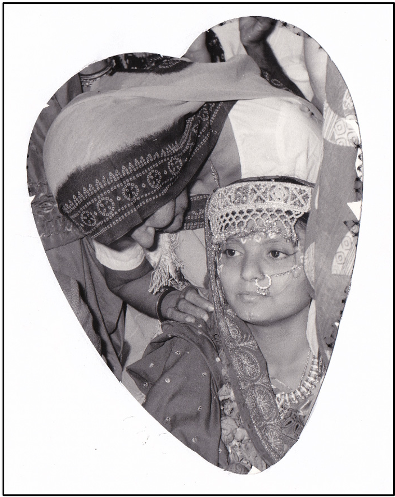
My Mother seeing Sumi for the first time
Everything suddenly stopped and riveted on my mother’s reaction. If she did not approve of the bride she could have stopped the wedding. But my mother was very pleased and gave her blessing. Everything resumed in slow motion and we proceeded to finish the seven rounds around the Fire, repeating the following vows in Sanskrit after the priest:
We have taken the Seven Steps. You have become mine forever. Yes, we have become partners. I have become yours. Hereafter, I cannot live without you. Do not live without me. Let us share the joys. We are the word and meaning, united. You are thought and I am sound. As the heavens are stable, as the earth is stable, as the mountains are stable, as the whole universe is stable, so may our union be permanently settled.
A shorter equivalent of these vows in a Catholic wedding would be:
I take you to be my lawfully wedded wife, to have and to hold, from this day forward, for better, for worse, for richer, for poorer, in sickness and in health until death do us part.
.png.aspx)
Tying a knot – We have become partners
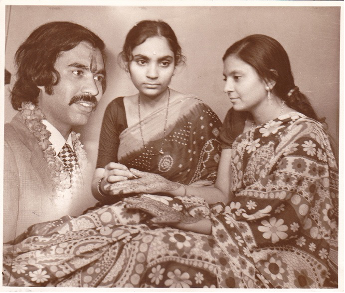
Sumi’s friend applying mehndi (henna) on Sumi’s hands
(Photographer superimposed my photo
After reciting our vows in Sanskrit, we legally became husband and wife. Now, when I look back, I realize I met Sumi when I was twenty-six and she was nineteen. I proposed to her on May 8
th, her twentieth birthday. What a birthday gift! Ours may have been a rare wedding, where all the invitations were personally and verbally delivered because there was no time to print and mail them.
After a brief honeymoon at the Taj Mahal Hotel in Mumbai and spending two more weeks in Mumbai with Sumi and my family, I returned to the US on May 26
th. Sumi stayed back to get her passport, take her medical exam for her US Visa, and then wait for her Visa card. And finally, Sumi joined me four months later on September 29, 1974 in Philadelphia.
Upon my return, I resumed my job at D. Becker & Sons. My boss, Alan Becker, who had helped me get my Green Card had also given me an advance to deposit in my bank to show I had enough money to support my wife when she came to the US. Recently, Alan who lives near Philadelphia and just turned eighty-eight, confided in me that his partners had not been keen on the help he’d given me. Alan was very happy and relieved I had resumed my work after my trip because all along his partners thought I would never return and their investments in me would have been a bad gamble.

Newlywed Sumi in deep thoughts
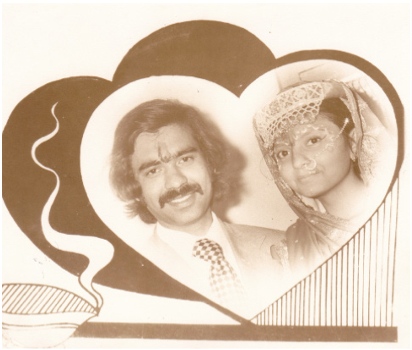
Let the flame burn forever
Over the years, when the subject of marriage came up people would ask, “Was your marriage arranged?” My answer would be everything I had just described. And then I would let them decide.
Even today, the question remains,
was our marriage arranged?